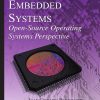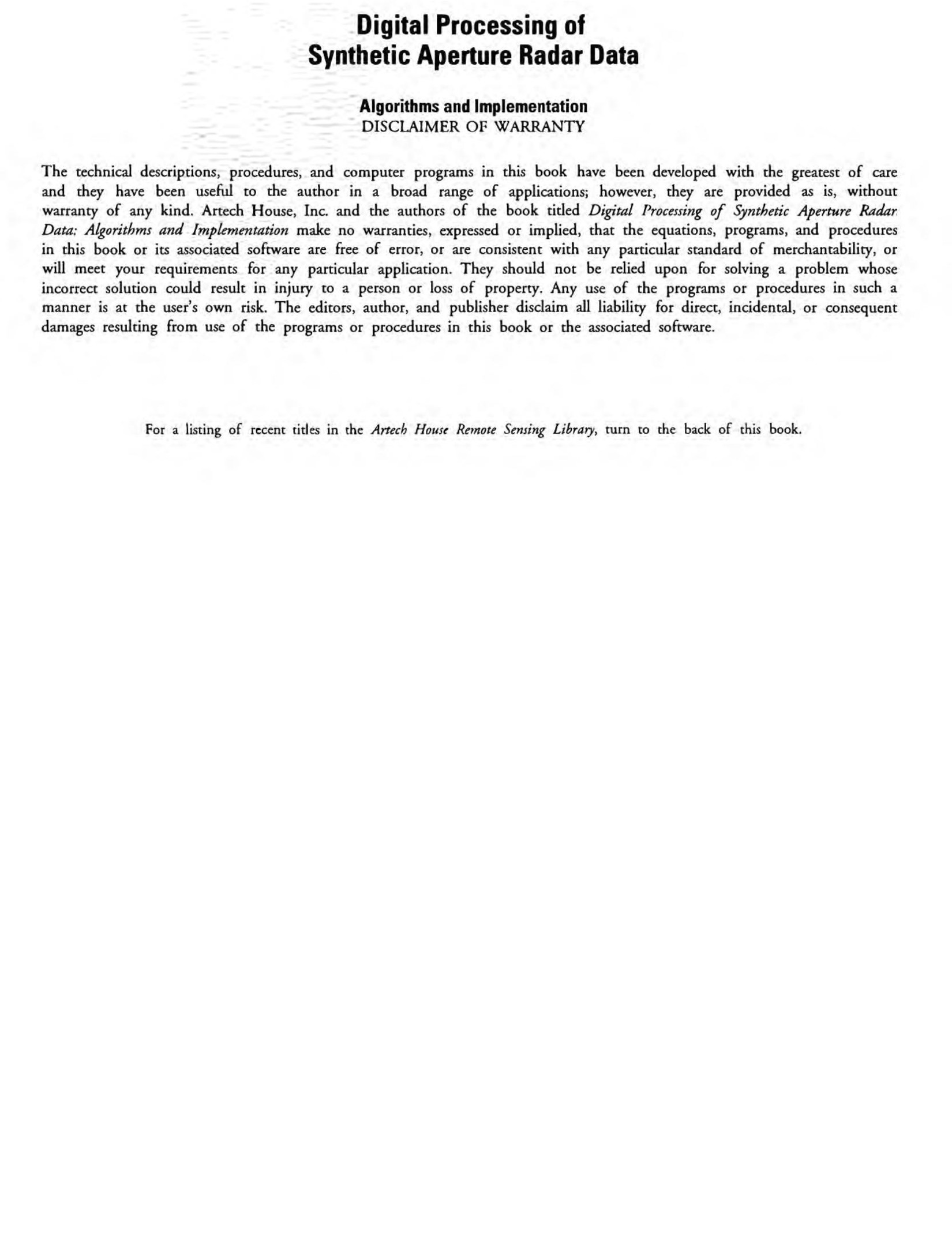Digital Processing of Synthetic Aperture Radar Data Algorithms and Implementation 1st Edition by Ian Cumming, Frank Wong ISBN 9781461473812 1461473810
$70.00 Original price was: $70.00.$35.00Current price is: $35.00.
Instant download Digital Processing of Synthetic Aperture Radar Data Wei Zhi after payment
Digital Processing of Synthetic Aperture Radar Data: Algorithms and Implementation 1st Edition by Ian G. Cumming, Frank H. Wong – Ebook PDF Instant Download/Delivery: 9781461473812 ,1461473810
Full dowload Digital Processing of Synthetic Aperture Radar Data 1st Edition after payment

Product details:
ISBN 10: 1461473810
ISBN 13: 9781461473812
Author: Ian G. Cumming, Frank H. Wong
Synthetic Aperture Radar (SAR) is of major interest to radar professionals because it allows them to obtain high-resolution images with unsurpassed clarity from satellites that take pictures of the earth’s surface in all weather conditions. This cutting-edge resource offers complete how to guidance on digital processing of synthetic aperture radar (SAR) data. Professionals discover precisely how this radar system works and gain an in-depth understanding of the properties of SAR data. The book explains how digital computers are used to form the focused image and provides practitioners with state-of-the-art processing algorithms that they can use for their projects. Written from a signal processing point of view, this authoritative volume can be fully understood by professionals and students with a general electrical engineering background.
Digital Processing of Synthetic Aperture Radar Data: Algorithms and Implementation 1st Edition Table of contents:
I Fundamentals of Synthetic Aperture Radar
1 Introduction
1.1 Brief Background of SAR
1. 2 Radar in Remote Sensing
1.3 SAR Fundamentals
1.4 Spaceborne SAR Sensors
1.5 Outline of the Book
1.5.1 Example of a Spaceborne SAR Image
References
2 Signal Processing Fundamentals
2.1 Introduction
2.2 Linear Convolution
2.2.1 Continuous-Time Convolution
2.2.2 Discrete-Time Convolution
2.3 Fourier Transforms
2.3.1 Continuous-Time Fourier Transform
2.3.2 Discrete Fourier Transform
2.3.3 Fourier Transform Properties
2.3.4 Examples of Fourier Transforms
2.4 Convolution Using DFTs
2.5 Sampling of Signals
2.5.1 Spectrum of Sampled Signals
2.5.2 Signal Types
2.5.3 Nyquist Sampling Rate and Aliasing
2.6 Smoothing Windows
2. 7 Interpolation
2. 7.1 Sine Interpolation
2.7.2 Spectra of Interpolation Kernels
2.7.3 Nonbaseband and Complex Interpolation
2.8 Point Target Analysis
2.9 Summary
2.9.1 Magellan Image of Venus Crater
References
3 Pulse Compression of Linear FM Signals
3.1 Introduction
3.2 Linear FM Signals
3.2.1 Time Domain Representation
3.2.2 Spectrum of the Linear FM Pulse
3.2.3 Sampling of FM Signals
3.2.4 Frequency and Time Discontinuities
3.3 Pulse Compression
3.3.1 Principles of Pulse Compression
3.3.2 Time Domain Compression of Linear FM Signals
3.3.3 Frequency Domain Matched Filter
3.3.4 The Effect of Windows
3.3.5 Oversampling Ratio Revisited
3.4 Matched Filter Implementation
3.4.l Target Registration and Matched Filter Throwaway
3.5 FM Rate Mismatch
3.5.1 Effect of Mismatch 1n a Baseband Signal
3.5.2 Effect of Mismatch 1n a Nonbaseband Signal
3.5.3 Filter Mismatch and Time Bandwidth Product
3.6 Summary
3.6.1 A Wide Swath ENVISAT/ASAR Image
References
Appendix 3A: Derivation of the Matched Filter Output
3A.1 Signal and Matched Filter of Equal Length
3A.2 Signal and Matched Filter of Unequal Length
Appendix 3B: Derivation of the Phase Error Due to Mismatch
4 Synthetic Aperture Concepts
4.1 Introduction
4.2 SAR Geometry
4.2.1 Definition of Terms
4.2.2 Satellite Ground Range Geometry
4.2.3 Satellite Orbit Geometry
4.3 The Range Equation
4.3.1 Hyperbolic Form of the Range Equation
4.3.2 Relationships Between Velocities and Angles
4.4 SAR Signal in the Range Direction
4.4.1 Transmitted Pulse
4.4.2 Data Acquisition
4.5 SAR Signal in the Azimuth Direction
4.5.1 What Is Doppler Frequency in the SAR Context?
4.5.2 Coherent Pulses
4.5.3 Choice of PRF
4.5.4 Azimuth Signal Strength and Doppler History
4.5.5 Azimuth Parameters
4.6 The Two-Dimensional Signal
4.6.1 Data Arrangement in Signal Memory
4.6.2 Demodulated Baseband Signal
4.6.3 The SAR Impulse Response
4.6.4 Typical Radar Parameter Values
4. 7 SAR Resolution and Synthetic Aperture
4.7.1 Resolution Derived from Bandwidth
4.7.2 Synthetic Aperture
4.8 Summary
4.8.1 ScanSAR Narrow Image of Vancouver Island
References
Appendix 4A: Derivation of the Approximate Radar Velocity
Appendix 4B: Quadrature Demodulation
4B.l Theory of Quadrature Demodulation
4B.2 Errors and Corrections
Appendix 4C: Concept of Synthetic Aperture
5 SAR Signal Properties
5.1 Introduction
5.2 Signal Spectrum in the Low-Squint Case
5.2.1 Spectrum in the Range Doppler Domain
6.2.2 Two-Dimensional Spectrum
5.3 Signal Spectrum in the General Case
5.3.1 Range Fourier Transform
5.3.2 Azimuth Fourier Transform
5.3.3 Range Inverse Fourier Transform
6.4 Azimuth Aliasing and the Doppler Centroid
5.4.1 Origin of Azimuth Aliasing and Ambiguities
5.4.2 The Doppler Centroid
5.4.3 The Doppler Ambiguity
5.4.4 Doppler Centroid Variation with Range
5.5 Range Cell Migration
5.5.1 RCM Components
5.5.2 Multiple Targets at the Same Range
5.5.3 Target Trajectory Wraparound
5.6 Point Target Examples
5.6.1 Simulation Parameters
5.7 Prelude to SAR Processing Algorithms
5.7.l Time Domain Matched Filtering
5.7.2 Real-Time Processed Airborne Radar Image
5.7.3 Unfocused SAR
5.7.4 Moving on to Better Processing Algorithms
5.8 Summary
References
Appendix 5A: Range/Azimuth Coupling
Appendix 5B: A Note on the Azimuth FM Rate
5B.1 Geometric Interpretation from Slopes
5B.2 Approximate Signal Representation
II SAR Processing Algorithms
6 The Range Doppler Algorithm
6.1 Introduction
6.2 Algorithm Overview
6.3 RDA in the Low Squint Case
6.3.1 Raw Radar Signal Data (Raw Data)
6.3.2 Range Compression
6.3.3 Azimuth Fourier Transform
6.3.4 Range Cell Migration Correction
6.3.5 Broadening Due to Residual RCM
6.3.6 Azimuth Compression
6.3.7 Example of a Low Squint RADARSAT-1 Image
6.4 The High Squint Case
6.4.1 Modifications to Handle Squint
6.4.2 Implementation of SRC
6.4.3 SRC Options Needed for Satellite and Airborne Cases
6.4.4 SRC Simulation Experiments
6.4.5 An L-Band Airborne Radar Image Example
6.5 Multilook Processing
6.5.1 Frequency and Time Relationship of Looks
6.5.2 Look Extraction, Detection1 and Summation
6.6.3 Equivalent Number of Looks
6.5.4 An Example of Multilook Processing
6.5.5 FM Rate Error
6.5.6 Multilook Processed Image
6.6 Summary
References
7 The Chirp Scaling Algorithm
7.1 Introduction
7.1.1 Overview of the Chirp Scaling Algorithm
7.2 The Chirp Scaling Concept
7.3 Applying Chirp Scaling to RCMC
7.3.1 Bulk and Differential RCMC
7.3.2 A More Accurate Expression for RCM
7.4 Derivation of the Scaling Function
7.4.1 Examples of the Size of Differential RCM
7.5 CSA Processing Details
7. 5 .1 Range Processing
7.5.2 Azimuth Processing
7.6 Processing Examples
7.6.1 Simulations with Point Targets
7.6.2 Processing of SRTM/X-SAR Data
7.7 Summary
References
8 The Omega-K Algorithm
8.1 Introduction
8.1.1 Overview of the Omega-K Algorithm
8.2 Reference Function Multiply
8.3 Stolt Interpolation
8.3.1 The Change of Variables
8.4 Interpretations of the Stolt Mapping
8.4.1 Components of the Stolt Mapping
8.4.2 Interpretation Via Fourier ‘Iransform Properties
8.4.3 Interpretation Via the Region of Support
8.4.4 Interpretation Via Imaging Geometry
8.5 Error Analysis
8.6 Approximate Version of the Omega,…K Algorithm
8.6.1 Approximation Components
8.6.2 Relation to the RDA and the CSA
8.6.3 Discussion of Errors in the Approximate WKA
8. 7 Processing Examples
8.7.1 Simulation of the Full WKA Algorithm
8. 7 .2 Approximate Version of the WKA
8.7.3 An X-Band Airborne Radar Spotlight Image Example
8.8 Summary
References
Appendix BA: Stolt Mapping m the Wavenumber Domain
9 The SPECAN Algorithm
9 .1 Introduction
9.1.1 Overview of the SPECAN Algorithm
9.2 Derivation of the SPECAN Algorithm
9.2.1 From Convolution to SPECAN
9.2.2 Geometric Interpretation
9.2.3 Aliasing and FFT Length
9.2.4 Output Sample Spacing
9.2.5 Number of Good FFT Output Points
9.2.6 Placement of Subsequent FFTs
9.2.7 Stitching the FFT Outputs Together
9.3 Multilook Processing
9.4 Processing Efficiency
9.5 Range Cell Migration Correction
9.5.1 Time Domain Linear RCMC
9.5.2 Skewing and Deskewing
9.6 Phase Compensation
9. 7 Image Quality Issues
9. 7 .1 Frequency Discontinuities at the Stitching Points
9.7.2 Azimuth FM Rate Error
9.7.3 Radiometric Scalloping
9.8 Processing Examples
9.8.1 Simulated Point Targets
9.8.2 ERS Image Processed by SPECAN
9.9 Summary
References
10 Processing ScanSAR Data
10.1 Introduction
10.2 ScanSAR Data Acquisition
10.3 Compression of a Single-Burst Target
10.4 Full-Aperture Processing
10.6 The SPECAN Algorithm
10.6 The Modified SPECAN Algorithm
10.6.1 Outline of the Algorithm
10.6.2 SRTM Processing Example
10. 7 The Short IFFT Algorithm
10.8 The Extended Chirp Scaling Algorithm
10.9 Stitching Processed Bursts Together
10.10 Summary
10.10.1 RADARSAT-1 ScanSAR Image
References
11 Comparison of Algorithms
11.1 Introduction
11.2 Recap of the Precision Processing Algorithms
11.2.1 Range Doppler Algorithm
11.2.2 Chirp Scaling Algorithm
11.2.3 Omega-K Algorithm
11.3 Comparison of Processing Functions
11.3.1 Form of Range Equation
11.3.2 Implementation of the Azimuth Matched Filter
11.3.3 Implementation of Range Cell Migration Correction
11.3.4 Implementation of Secondary Range Compression
11.4 Summary of Processing Errors
11.4.l QPE 1n the Azimuth Matched Filter
11 .4.2 QPE in Secondary Range Compression
11.4.3 Residual RCM
11.4.4 Examples of the Size of the Processing Errors
11.5 Computation Load
11.5.1 Basic Algorithm Operations
11.5.2 Range Doppler Algorithm
11.5.3 Chirp Scaling Algorithm
11.5.4 Omega-K Algorithm
11.6 Pros and Cons of Each Algorithm
11.6.1 Pros and Cons of the RDA
11.6.2 Pros and Cons of the CSA
11.6.3 Pros and Cons of the WKA
11 . 7 Summary
11.7.1 ASAR Image of the Strait of Messina
III Doppler Parameter Estimation
12 Doppler Centroid Estimation
12.1 Introduction
12.1.1 Doppler Centroid Frequency
12.1.2 Satellite SAR System Geometry
12.1.3 Outline of This Chapter
12.2 Doppler Centroid Accuracy Requirements
12.2.1 Baseband Centroid Accuracy Requirements
12.2.2 Doppler Ambiguity Accuracy Requirements
12.3 Calculating Doppler Centroid from Geometry
12.3.1 Examples of Doppler Centroid Calculations
12.3.2 Yaw and Pitch Steering
12.4 Estimation of the Baseband Centroid from Received Data
12.4.1 Magnitude-Based Estimation Approach
12.4.2 Phase-Based Estimation Method
12.5 Estimation of the Doppler Ambiguity from Received Data
12.5.1 A Magnitude-Based DAR Estimation Method
12.5.2 Phase-Based DAR Estimation Methods
12.5.3 The Wavelength Diversity Algorithm
12.5.4 Multilook Cross Correlation Algorithm
12.5.5 Multilook Beat Frequency Algorithm
12.5.6 PRF Diversity Method
12.5.7 Comparison of DAR Algorithms
12.6 Principles of the Global Estimation Procedure
12.6.1 Spatial Diversity
12.6.2 Estimator Quality Measures
12. 7 Surface Fitting Approaches
12.7.1 Global Fit Using a Polynomial Surface
12.7.2 Global Fit Using a Geometry Model
12.7.3 Automatic Fitting Procedure
12.8 Summary
References
Appendix 12A: Details of the Doppler Calculation
Appendix 12B: The Offset Frequency in DAR Algorithms
12B.l Model of Signal from Each Look
12B.2 Multilook Cross Correlation Algorithm
12B.3 Multilook Beat Frequency Algorithm
13 Azimuth FM Rate Estimation
13.1 Introduction
13.2 Azimuth FM Rate Accuracy Requirements
13.3 Geometry Models to Compute the
Azimuth FM Rate
People also search for Digital Processing of Synthetic Aperture Radar Data: Algorithms and Implementation 1st Edition:
digital processing of synthetic aperture radar data pdf
synthetic aperture radar uses
synthetic aperture radar explained
synthetic aperture radar cost
digital processing of synthetic aperture radar data



